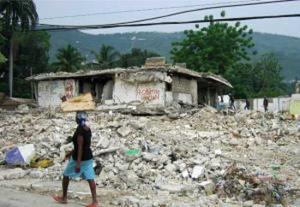DisastersRecycled Haitian concrete safe, strong, cheap
Nearly a year after the 7.0 magnitude earthquake, most of the damaged areas of Haiti are still in ruins; researchers find that concrete and other debris in Port-au-Prince could be safely and inexpensively recycled into strong new construction material which meets or exceeds the minimum strength standards used in the United States

This debris can be recycled into a strong material // Source: sciencedaily.com
Nearly one year after a 7.0-magnitude earthquake rocked the Republic of Haiti, engineering and concrete experts at Georgia Tech report that concrete and other debris in Port-au-Prince could be safely and inexpensively recycled into strong new construction material.
In a paper just published in the Bulletin of the American Ceramic Society, researchers Reginald DesRoches, Kimberly E. Kurtis and Joshua J. Gresham say that they have made new concrete, which meets or exceeds the minimum strength standards used in the United States, from recycled concrete fragments and other indigenous raw materials using simple techniques.
Most of the damaged areas of Haiti are still in ruins. The authors says their work points to a successful and sustainable strategy for managing an unprecedented amount of waste, estimated to be twenty million cubic yards.
“The commodious piles of concrete rubble and construction debris form huge impediments to reconstruction and are often contaminated,” says DesRoches, professor and Associated Chair of Civil and Environmental Engineering at Georgia Tech. “There are political and economic dilemmas as well, but we have found we can turn one of the dilemmas — the rubble — into a solution via some fairly simple methods of recycling the rubble and debris into new concrete.”
DesRoches, who was born in Haiti, traveled several times in 2010 to Port-au-Prince to gather samples of typical concrete rubble and additionally collect samples of two readily available sand types used as fine aggregates in some concrete preparation.
He and Gresham also studied the methods, tools and raw materials used by local laborers to make concrete mixes. DesRoches recalls they encountered no mixing trucks. “Instead, all of the construction crews were manually batching smaller amounts of concrete. Unfortunately, they were mixing volumes of materials ‘by eye,’ an unreliable practice that probably caused much of the poor construction and building failure during the earthquake,” he says.
Before leaving, DesRoches and Gresham manually cast an initial set of standard 3-inch by 6-inch concrete test cylinders using mixes currently in use at several different construction sites.
They returned to Georgia Tech with their cast blocks, sand samples and notes, where they were joined by Kurtis, also a professor and Chair of the American Concrete Institute’s Materials Science of Concrete Committee.
They quickly discovered that the concrete test samples cast contemporary Haitian mix was of poor quality. “The Haitian-made concrete had an average compressive strength of 1,300 pounds per square inch,” says Kurtis. “In comparison, concrete produced in the United
